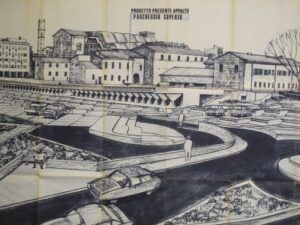A day of studies in Ravenna on the prestigious Superintendent of Cultural Heritage of Emilia Romagna to remember his teaching and protection activities in defense of the historical and artistic heritage of our country. Andrea Emiliani was also a rigorous fighter who did not hesitate to take sides, to oppose bad choices, to fight to avoid disasters or tampering. And he did it by strictly interpreting the role that he authoritatively held but not giving in, as unfortunately happens too often, to political pressure. In this memory of Sauro Turroni, his exemplary battle to prevent the ancient convent from being made a clean sweep of the ancient convent with the “Sacripanti project”: the church would be transformed into a stage, the sixteenth-century cloister into an audience, all raised, every architectural element would be state used as a scenic backdrop and much more. The conference today in Romagna at the “Mar di Ravenna”
◆ The article by SAURO TURRONI
► Today at the “Mar di Ravenna”, museum of which Andrea Emiliani was honorary president for about 20 yearsone is held day of studies dedicated to him, aimed at Romagna, its land of origin and also a privileged place of studies and research. It is an important opportunity to remember this teaching and activities for the study and protection of the territory together with the set of policies for cultural heritage and the other infinite activities in favor, for the knowledge and defense of the historical and artistic heritage of the Nationincluding everything that, simplifying, we could define as part of the material culture and identity of places.
Andrea Emiliani, however, was not only the extraordinary scholar and teacher that we all remember and to whom culture, art history, museums and even conservation policies owe a lot but, if I may, he was also a rigorous fighter who did not hesitate to take sides, to oppose bad choices, to fight to avoid disasters or tampering. And she did it by strictly interpreting the role that she authoritatively held but not giving in, as unfortunately happens too often, to political pressures that since the introduction of the rules that allow politics itself to appoint officials, they see them giving in to requests that are even contrary to their duties of protection. An exemplary story that testifies to the commitment, rigor and determination of Andrea Emiliani, who was also willing to clash harshly with administrators, entire parties and even parliamentarians, is represented by project of a new theater in Forlì by architect Maurizio Sacripantiwhich would have the ancient convent of San Domenico and the church of San Giacomo were tampered with and devastated.
The story is very long, it concerns a very central area in the city in which one existed ancient felt factory in the process of being decommissioned which has been the subject of attention since the 1950s. Yes In one of his masterly articles from 1953, Cederna spoke of the desire of the administrators of the time to demolish everythingleaving the few monumental buildings present standing to create a large free space to be used for future building developments. The city was without a theater, demolished during the war and in 1977 the Municipality announced a national competition of ideas for the design of a theater in the area of the former Bonavita factory, which has since been demolished. Numerous qualified design groups participated in the competition and the architect Sacripanti’s project won. It was about a invasive project, which affected the San Domenico convent and included a covered car park adjacent to the 2nd cloister clogging and altering the entire area. Neglect in 1978 caused one side of the church and a section of the first cloister to collapse. The debate that arose in the meantime around the Sacripanti project had already highlighted its excessive size. The collapse suggested place the theater in the church and soon the new project was ready. It was a massacre: the church would have been transformed into a stage, the sixteenth-century cloister into an audience, all raised, every architectural element would have been used as a scenographic backdrop and much more. The perspective images prepared by Sacripanti revealed an intervention incompatible with church and convent. On 17 February 1981 the preliminary project was approved by the Council: only 3 abstentions. Only the Honorable Ascari of the PRI gave reasons for his dissent.

Meanwhile the Municipality started the construction of a car park made up of concrete spurs and a sort of elevated square that even today it blocks the view of the church and convent and invades the adjacent streets with terrible interchanges. The parking lot will soon be nicknamed bunker, while the square will be derogatorily “the boat”. Few opposed all this, a quintet of diehards, among them Pier Luigi Cervellati and Marina Foschi, presented an observation that the Municipality rejected. Remark will also be sent to the Region. The conflict immediately became bitter, some political forces began to distance themselves from the project following Italia Nostra and the Greensthe parking aroused indignation, many citizens protested and then the DC, some republicans and some exponents of the PSI expressed their growing opposition.
A very large group of eminent men of culture, from Cederna to Leonardo Benevolo, from Italo Insolera to Bruno Gabrielli, from Vezio De Lucia to Antonio Iannello to Mario Fazio and many others took a stand. The same regional councilor Felicia Bottino spoke out against the project. The Administration was insensitive and tenacious to every second thought; indeed, promoted with the support of some local architects and engineers strenuous resistance to the reasoned positions of the intellectuals who had mobilised. The PCI, the city’s governing party, took refuge and argued that it was a conflict between schools of thought, that it was possible to intervene with new buildings on the historical fabric of the city and on its own buildings.

The one that many will later define a tour company, made up of Sacripanti’s colleagues and associates, mobilized to support the project, the clash took on a supra-communal significance between the supporters of the restoration and those who instead defended the right to tampering. It was difficult to find points of agreement with the Municipality and therefore it was the time of complaints, complaints, appeals, parliamentary and regional questions but the machine did not stop: the administration had part of the money and intended to contract the work as soon as possible.
Here he entered the field superintendent Emiliani which, after an inspection, decided to carry out an intervention for the restoration of the decorative elements of the church. He had the Ministry finance 700 million lire of the works, he installed a construction site inside the San Giacomo and began the restoration of the surviving decorative devices and opened a school construction site. All hell broke loose. It was a matter of “the autonomy of the Municipality being undermined”, a fiery municipal council meeting took place, the superintendent was accused of a “fascist” by the mayor and city councilors, the school building site he designed for young restorers was badly rejected. We read in the transcript of the session “How is it possible that the superintendent, Mr. Emiliani, make plans without asking anything from the owner body of the Municipality of Forlì? It happens that there are certain characters that I wrote to you three years ago, who are fascists…”, while others spoke of “pure indecency” and uttered various insults.
A poster signed by the communist mayor Giorgio Zanniboni was posted in the city which read “Forlivesi… a composite front of forces took the field against a project approved by the Superintendence, Ministry of Cultural Heritage… these are parties and movements …who make defeatism their flag, of associations that didn’t worry about San Domenico when it was falling apart… of some people from outside Forlì… who, perhaps nostalgic for Minculpop or widowers of Zhdanovism, attack the project because it doesn’t meet the recovery criteria of the old buildings that they want to impose, in a country and in a Europe that gives citizenship to many other authoritative schools”. The invective still continued but it didn’t make a dent an imperturbable Andrea Emiliani That he calmly continued to maintain that he was doing nothing more than his specific dutyrejecting any attempt to involve him in the controversy.

The Municipality, in the meantime, in 1988 made a new general master plan for the historic centre which, for San Domenico, included conservative restoration, and sent it to the Region for approval. It was a cold shower: the regional councilor Bottino had a vision in agreement with that of Emiliani, Cederna and all the other opponents and canceled the San Domenico project. Again she was revolted. However, the contract could no longer be made. More years will pass. In ’91, the crazy project was abandoned and a new administration was finally convinced to start a restoration project of the church and convent that would give the city back a place for the city museum and for the exhibitions that the Foundation will set up in the following years.
Politics, however, did not forget the central role played by Andrea Emiliani in his defeat and therefore a sort of barely concealed ostracism was triggered. However, they were unable to do anything when years later at the inauguration of the restored San Giacomo the city had to pay homage to those who had saved that important cultural asset, making him go up, alone, on stage to receive the applause and thanks of everyone, even those who had opposed him. That battle continues to this day. Half of the bunker car park has been demolished but the same forces that shared the obviously unknown merit of having returned the ancient San Domenico to the city are committed, also in honor of Andrea Emiliani, to the demolition of the “boat” and for the modern reconstruction of the ancient vegetable gardens erased by two centuries of concrete. © ALL RIGHTS RESERVED
Tags: massacre convent San Domenico Forlì stopped rigorous fighter Andrea Emiliani Italia Libera









